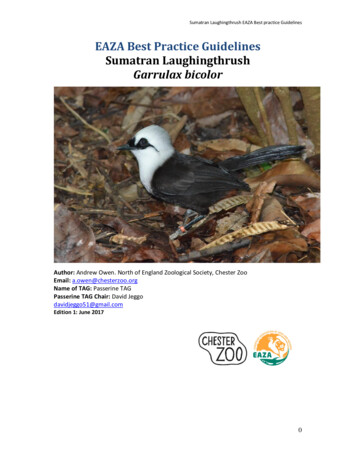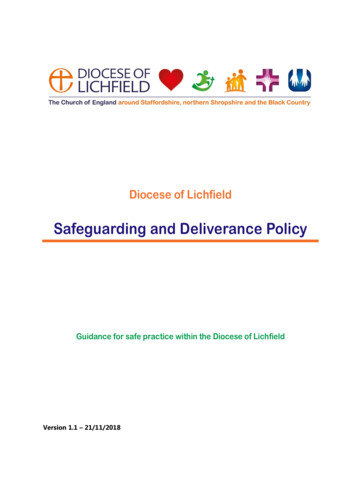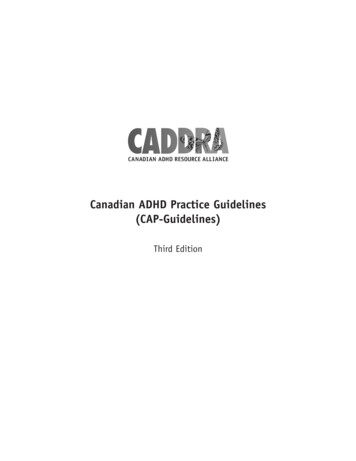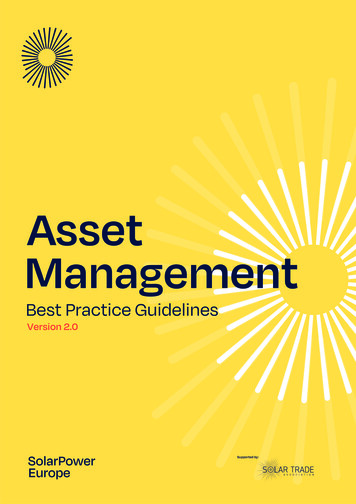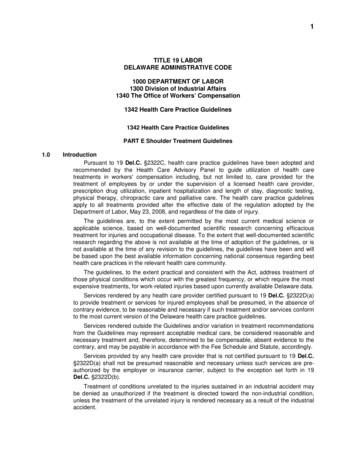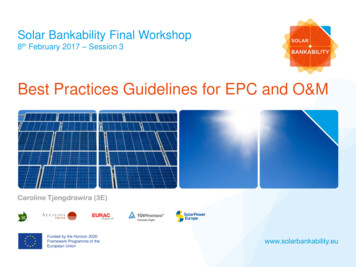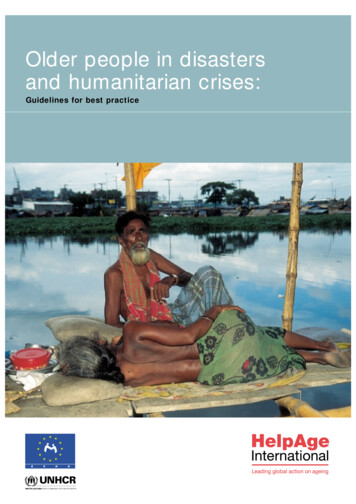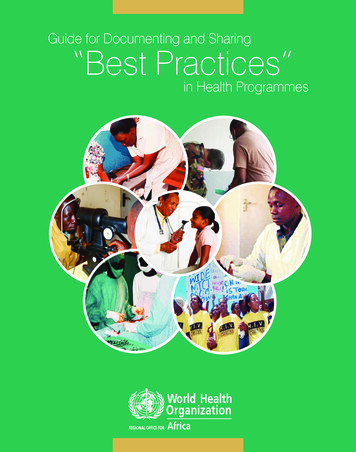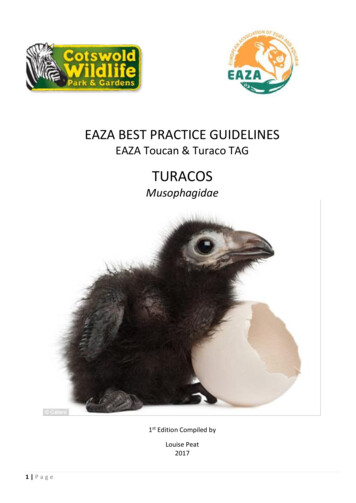
Transcription
EAZA BEST PRACTICE GUIDELINESEAZA Toucan & Turaco TAGTURACOSMusophagidae1st Edition Compiled byLouise Peat20171 Page
Front cover;Lady Ross’s chick. Photograph copyright of Eric Isselée-Life on White, taken at Mulhouse ouse.com/Author: Louise Peat. Cotswold Wildlife ParkEmail: records@cotswoldwildlifepark.co.ukName of TAG: Toucan & Turaco TAGTAG Chair: Laura GardnerE-mail: Laura.gardner@zsl.org2 Page
EAZA Best Practice Guidelines disclaimerCopyright 2017 by EAZA Executive Office, Amsterdam. All rights reserved. No part of this publication maybe reproduced in hard copy, machine-readable or other forms without advance written permission fromthe European Association of Zoos and Aquaria (EAZA). Members of the European Association of Zoos andAquaria (EAZA) may copy this information for their own use as needed.The information contained in these EAZA Best Practice Guidelines has been obtained from numeroussources believed to be reliable. EAZA and the EAZA Toucan & Turaco TAG make a diligent effort to providea complete and accurate representation of the data in its reports, publications, and services. However,EAZA does not guarantee the accuracy, adequacy, or completeness of any information. EAZA disclaims allliability for errors or omissions that may exist and shall not be liable for any incidental, consequential, orother damages (whether resulting from negligence or otherwise) including, without limitation, exemplarydamages or lost profits arising out of or in connection with the use of this publication.Because the technical information provided in the EAZA Best Practice Guidelines can easily be misread ormisinterpreted unless properly analysed, EAZA strongly recommends that users of this information consultwith the editors in all matters related to data analysis and interpretation.PreambleRight from the very beginning it has been the concern of EAZA and the EEPs to encourage and promote thehighest possible standards for husbandry of zoo and aquarium animals. For this reason, quite early on,EAZA developed the “Minimum Standards for the Accommodation and Care of Animals in Zoos andAquaria”. These standards lay down general principles of animal keeping, to which the members of EAZAfeel themselves committed. Above and beyond this, some countries have defined regulatory minimumstandards for the keeping of individual species regarding the size and furnishings of enclosures etc., which,according to the opinion of authors, should definitely be fulfilled before allowing such animals to be keptwithin the area of the jurisdiction of those countries. These minimum standards are intended to determinethe borderline of acceptable animal welfare. It is not permitted to fall short of these standards. Howdifficult it is to determine the standards, however, can be seen in the fact that minimum standards varyfrom country to country.Above and beyond this, specialists of the EEPs and TAGs have undertaken the considerable task of layingdown guidelines for keeping individual animal species. Whilst some aspects of husbandry reported in theguidelines will define minimum standards, in general, these guidelines are not to be understood asminimum requirements; they represent best practice. As such the EAZA Best Practice Guidelines forkeeping animals intend rather to describe the desirable design of enclosures and prerequisites for animalkeeping that are, according to the present state of knowledge, considered as being optimal for eachspecies. They intend above all to indicate how enclosures should be designed and what conditions shouldbe fulfilled for the optimal care of individual species.CitationThis publication should be cited as follows:EAZA Turaco Best Practice Guidelines; L. Peat; Cotswold Wildlife Park; April 20173 Page
IntroductionThe information in this Best Practice Guideline has come from several sources; other literature, andpersonal experiences from both the author (EAZA sub-group leader for turaco species) and personalcommunication with other holders.Some aspects of husbandry are still a work in progress; there are always new opportunities to improve ourknowledge and husbandry of captive turaco species. There are certainly areas of turaco husbandry that arein need of further research, namely: nutrition, mate aggression, group dynamics, analysis of health issuesand mortality rates.In general turaco species are very gratifying additions to our aviaries adding diversity, colour and character.They can be mixed with other species; any African themed exhibit would not be complete without theiconic turaco territorial calls and flash of red as they fly from perch to perch.This Guideline has been reviewed and approved by other turaco TAG members.Edited by Jess Borer.Key husbandry points:1. Most important aspect of husbandry starts with nutrition, not enough research has been done inthis area yet to give decisive recommendations, but would advise a high fibre diet and limitamounts of sweet commercially grown fruits.2. The two most common causes of mortality for captive turaco species are Yersinia and mateaggression. Good hygiene practices, pest control and astute behavioural observations essential.Certain species considered more prone to mate aggression. Research is currently being conductedto try to get a better understanding of this behaviour.3. Suitable aviary design - very well planted & plenty of horizontal perching to enable naturallocomotion.4 Page
ContentsPageSECTION 1. BIOLOGY AND FIELD DATA 6A: BIOLOGY 1.1 Taxonomy .1.2 Morphology .1.3 Anatomy .1.4 Physiology .1.5 Longevity .6612161717B: FIELD DATA 1.6 Conservation status/Zoogeography/Ecology .1.7 Diet and Feeding Behaviour 1.8 Reproduction .1.9 Behaviour .1717181920SECTION 2. MANAGEMENT IN CAPTIVITY .222.1 ENCLOSURE 2.1.1 Boundary 2.1.2 Substrate 2.1.3 Furnishings and Maintenance .2.1.4 Environment 2.1.5 Dimensions .2222222223232.2 FEEDING 2.2.1 Basic Diet .2.2.2 Special Dietary Requirements .2.2.3 Method of Feeding 2.2.4 Water .24263232322.3 SOCIAL STRUCTURE .2.3.1 Basic Social Structure .2.3.2 Changing Group Structure 2.3.3 Sharing Enclosure with Other Species .333333342.4 BREEDING .2.4.1 Mating .2.4.2 Egg Laying and Incubation .2.4.3 Hatching .2.4.4 Development and Care of Young .2.4.5 Foster rearing .2.4.6 Hand-Rearing .444444464647482.5 POPULATION MANAGEMENT .2.5.1 Population Status .2.5.2 Individual Identification and Sexing .4949542.6 HANDLING .2.6.1 General Handling .2.6.2 Catching/Restraining .2.6.3 Transportation .2.6.4 Safety .54545455552.7. HEALTH AND WELFARE .562.8 CONTACT ADDRESSES .612.9 RECOMMENDED RESEARCH .61SECTION 3. REFERENCES .62SECTION 4. APPENDICES – Turaco Bibliography, Denis Vrettos . 635 Page
SECTION 1. BIOLOGY AND FIELD DATAA: BIOLOGY1.1 sophagaeFamily:Musophagidae – 3 subfamilies – 6 genera – 23 species – 38 taxaFamily: MusophagidaeSubfamily: CorythaeolinaeGenus: CorythaeolaSpeciesCommon NameOther common namesDistributionIUCNListing (*)CITESListingRCPCorythaeola cristataGreat blueturacoGreat turaco(Great) blue plantain-eaterEquatorial Africa from Guinea Bissau, Guinea, Liberia and Ivory Coast Eto Nigeria, Central African Republic, Cameroon, Bioko, Gabon, NAngola, Congo, Democratic Republic of the Congo, S Sudan, Uganda,Rwanda, Burundi, NW Tanzania and W KenyaLeastconcernNAMon-PBirdLife International Factsheet at-blue-turaco-corythaeola-cristataSubfamily: Musophaginae6 Page
Genus: TauracoSpecies &SubspeciesCommon NameOther common namesDistributionIUCNListingCITESListingRCPTauraco persaGreen turacoGreen lourieGuinea/Green-crestedturacoIvory Coast and Ghana E to Mt Cameroon and BamendaHighlandsLeastconcernIIEU Annex BMon-PBirdLife International Factsheet en-turaco-tauraco-persaT. p. buffoniBuffon’s turacoSenegal & Gambia to Liberia.Mon-PT. p. zenkeriZenker's turacoS Cameroon, Gabon, N Angola, Congo and NW DRC.Mon-PTauraco livingstonii Livingstone’sturacoLivingstone’s lourieHighlands E of the Rift in Malawi and adjacent NMozambique, S to E Zimbabwe.LeastconcernIIEU Annex BLeastconcernIIEU Annex BLeastconcernIIEU Annex BBirdLife International Factsheet ingstones-turaco-tauraco-livingstoniiT. l. reichenowiNguru and Uluguru Mts SE to Dabaga and NjombeHighlands, TanzaniaReichenow'sturacoCoastal lowlands of Tanzania S of R Mligasi throughMozambique to NE ZululandT. l. cabanisiTauraco schalowiSchalow’sturacoLong-crested turacoW, C & E Angola, S DRC and Zambia to Zimbabwe, Malawi and WTanzania from Ufipa to Gombe Stream National Park; smallerpopulation in SW Kenya and N Tanzania from Mara Game Reserve andLoita Hills S to N & W Serengeti National Park, Crater and MbuluHighlands and Mt Hanang, and W to Mwanza District.BirdLife International Factsheet alows-turaco-tauraco-schalowiTauraco corythaixKnysna turacoKnysna lourieNatal, W Zululand and S Swaziland to S & E CapeProvince.BirdLife International Factsheet sna-turaco-tauraco-corythaix7 Page
Species & Subspecies Common NameDistributionIUCN ListingCITES ListingLeastconcernIIEU Annex BNearthreatenedIIEU Annex BLeastconcernIIEU Annex BLeastconcernIIEU Annex BRCPE & N Limpopo and NW SwazilandT. c. phoebusTauraco schuettiOther common namesBlack-billed turacoDRC E to Ituri basin, S to Angolan border.BirdLife International Factsheet ck-billed-turaco-tauraco-schuettiiS Sudan, E DRC, Uganda and W Kenya to NW Tanzania, Burundi andRwandaT. s. eminiTauraco fischeriFischer’s turacoS Somalia, coastal Kenya, and NE Tanzania from E UsambarasS to R WamiBirdLife International Factsheet chers-turaco-tauraco-fischeriZanzibarT. f. oSierra Leone E to GhanaBirdLife International Factsheet low-billed-turaco-tauraco-macrorhynchusT. m. verreauxiiVerreaux’sturacoNigeria, Cameroon and Bioko S to Gabon, SW Congo, W DECand N AngolaTauracoleucolophusWhite-crestedturacoSE Nigeria, N Cameroon E across S Chad and N Central AfricanRepublic to SW and S Sudan, NE DRC, N & C Uganda and WKenyaBirdLife International Factsheet maniBannerman’sturacoBamenda-Banso Highlands of NW CameroonBirdLife International Factsheet nermans-turaco-tauraco-bannermani8 PageEndangered IEU Annex AESB
Species &SubspeciesCommon NameOther common erythrolophusRed-crestedturacoPink-crested turaco,Pauline turacoW & C Angola from lower R Congo S to Chingoroi area,and E to Malanje and upper R CuanzaLeastconcernIIEU Annex BESBLeastconcernIIEU Annex BMon-PLeastconcernIIEU Annex BMon-PVulnerableIILeastconcernIIEU Annex BBirdLife International Factsheet -crested-turaco-tauraco-erythrolophusTauraco hartlaubiKenyan Highlands, extending into E Uganda at MtsMorongole, Moroto, Kadam, Debasien and Elgon, and into NTanzania at Loliondo, Longido, Mt Meru and Mt Kilimanjaro,North and South Pares and W UsambarasHartlaub’sturacoBirdLife International Factsheet tlaubs-turaco-tauraco-hartlaubiTauraco leucotisEthiopian Highlands from SW Arussi, Shoa and SidamoProvinces, W to the Boma Plateau in SE Sudan, and N toEritreaWhite-cheekedturacoBirdLife International Factsheet te-cheeked-turaco-tauraco-leucotisT. l. donaldsoniDonaldson’sturacoTauraco ruspoliiRuspoli’s turacoSC Ethiopian Highlands in N Harrar, Arussi and N BalePrince Ruspoli’s turacoRestricted to S Ethiopia around Arero, Bobela, Sokora,Neghelli and Wadera.BirdLife International Factsheet sPurple-crestedturacoViolet-crested turacoPurple-crested lourieZimbabwe and Mozambique S to E Limpopo and Natal.BirdLife International Factsheet ple-crested-turaco-gallirex-porphyreolophusT. p. chlorochlamys9 PageKenya through Tanzania, Burundi and Rwanda toZambia, Malawi and N Mozambique.
Genus: RuwenzorornisSpeciesCommon NameOther common ’s turacoDistributionRuwenzori Mts in NE DRC and SW Uganda; also E Zaireat Mulu and Mt KaboboIUCNListingCITESListingLeastconcernIIEU Annex BRCPBirdLife International Factsheet enzori-turaco-gallirex-johnstoniR. j. kivuensisMontane forests of Kivu Highlands of E DRC, Virungavolcanoes and Nyungwe Forest of Rwanda and Burundi,and SW Uganda.Kivu turacoGenus: MusophagaMusophagaviolaceaViolet turacoViolaceous turacoViolet plantain-eaterS Senegal & Gambia and Guinea E to N Nigeria and NWCameroon, extending S to Ivory Coast, Ghana and Togo;also an isolated population in extreme S Chad and NCentral African Republic.LeastConcernESBLeastconcernMon-PBirdLife International Factsheet let-turaco-musophaga-violaceaMusophaga rossaeRoss’s turacoRoss’s lourieLady Ross’sturaco/Plantain-eaterNE & E DRC, S Sudan, Uganda, W Kenya, NW Tanzania,Rwanda and Burundi to S Zaire, N & E Angola and NZambia; isolated populations in NE Gabon, Cameroon, NCentral African Republic.BirdLife International Factsheet ss-turaco-musophaga-rossae10 P a g e
Subfamily: CriniferinaeGenus: CorythaixoidesSpeciesCommon NameOther common namesCorythaixoidesconcolorGrey go-awaybirdGrey lourieDistributionS Malawi and N Mozambique S to E Limpopo, ESwaziland and E ZululandIUCNListingLeastconcernBirdLife International Factsheet hanesN E Angola through S DRC, Zambia and N Malawi to STanzania and N MozambiqueC. c. pallidicepsW Angola S to Namibia, extending seasonally to WBotswana.C. c. bechuanaeS & SE Angola and NE Namibia through Botswana to SWZambia, the Zimbabwe Plateau, and N & W LimpopoCorythaixoidespersonatusBare-faced goaway-birdBlack-faced lourieEthiopian Rift Valley from Dire Dawa and Ankober S to LAbaya and YavelloBirdLife International Factsheet wn-faced-go-away-bird-corythaixoides-personatusC. p. leopoldi11 P a g eS Uganda, Rwanda, Burundi, SW Kenya and Tanzania Sto N Malawi, NE Zambia and SE DRCLeastconcernCITESListingRCP
SpeciesCommon birdOther common namesDistributionE & NE Africa; NW, C & S Somalia, Ethiopia, S Sudan, NEUganda, N & E Kenya and S through to Tanzania.IUCNListingLeastconcernBirdLife International Factsheet enus: CriniferCrinifer piscatorWestern greyplantain-eaterGrey plantain-eaterS Senegal & Gambia, Sierra Leone coastal Liberia E toCentral African Republic, Congo and DRC.LeastconcernBirdLife International Factsheet tern-plantain-eater-crinifer-piscatorCrinifer zonurusEastern greyplantain-eaterEritrea, Ethiopian Rift Valley, S & W Sudan, N & NE DRCS through Uganda and Rwanda to SE DRC, W Burundi,NW Tanzania E to Mwanza, Serengeti, W Kenya, SEChad and N Central African RepublicLeastconcernBirdLife International Factsheet tern-plantain-eater-crinifer-zonurus(*) IUCN 2013. IUCN Red List of Threatened Species. Version 2013.2. www.iucnredlist.org . Downloaded on 14th May 2015.12 P a g eCITESListingRCP
1.2 MorphologyWith the exception of the larger great blue turaco, turaco species are medium sized birds, ranging in lengthfrom 40 to 75 cm, with long tails and short rounded wings. They are visually stunning, in particular thespecies that make up the subfamily Musophaginae, all brightly coloured gems of the forest. When theytake flight they display their trademark bright red primary wing feathers. Only the species from thesubfamily Criniferinae (plantain eaters and go-away-birds) have a more monochromatic grey and whiteplumage.Turaco are not built for flying distances or sustained flight, their flight appears weak and quite arduous.They are much more at home running along tree branches and hopping through vegetation, they areequipped with semi-zygodactylous toes, giving them impeccable arboreal locomotion.Image reproduced by kind permission from The Unfeathered Bird by Katrina van Grouw. http://www.unfeatheredbird.com/The majority of turaco are furnished with a feathered head crest (the longest being that of the Schalow’sturaco). The crests are generally held erect but can be adjusted at will and can signify various emotions,from excitement to fear.13 P a g e
They have strong and generally brightly coloured de-curved beaks capable of tearing soft flesh from fruitand vegetation.Unique to turaco is the presence of two copper pigments: Turacin which is responsible for the redcolouration and Turacoverdin which is responsible for green. All of the species in the subfamilyMusophaginae have both of these present. Turacin gives this subfamily their trademark red wing feathers,which are generally hidden away unless sun bathing or flying. Only the genus Crinifer and the white-belliedgo-away-bird are completely lacking both copper pigments.White-Cheeked Turaco Wing Feathers by CabinetCuriosities on deviantARTTuraco species are sexually monomorphic, with the only exception to this rule being the white-bellied goaway-bird, where the female has a yellow beak in comparison to the male’s black beak.Sex difference in white-bellied turaco.Image reproduced by kind permission fromHoward Robinson & International Turaco Society14 P a g e
1.3 AnatomyTuraco species have a broad back to accommodate the musculature required to clamber about in treetops;the back is slightly decurved, with a marked dip in the middle. The forest turacos have a dysfunctionalwishbone: the two halves do not meet in the middle like other avian species but are separated by a distinctgap, weakening the effect of their wingbeats. Birds of the subfamily Criniferinae are stronger fliers andtheir wishbone is complete, the two halves articulate in the midline but are not fused together into a solidcurve. (K.van Grouw. 2013).Image reproduced by kind permission from The Unfeathered Bird by Katrina van Grouw. http://www.unfeatheredbird.com/Selection of turaco skulls from www.skullsite.comViolaceous turaco15 P a g eLivingstone’s turacoGreen turaco
1.4 PhysiologyTuraco species have little or no ceca, a distensible esophagus with no crop, a thick muscular proventriculusand a thin-walled ventriculus, a relatively larger liver for their body size, and a short intestinal tract.(Fowler, 2012).Transit time of food through the digestive system is quite quick, in a timed experiment by the author thetime taken for food to pass from beak to excretion was 20 minutes.1.5 LongevityWild: UnknownCaptive: Generally late teens to early 20’s would be expected but there are documented cases of someindividuals getting into their 30’s, one documented case of a white-cheeked turaco female reaching 37years and still producing fertile eggs at the age of 34.Field data1.6 Conservation status/Zoogeography/EcologyDistribution:Endemic to sub-Saharan Africa.Habitat:Forest, woodland & savannah.Conservation status: IUCN Read List of Threatened Species list all species as Least concern withthe exceptions of: Bannerman’s turaco which is listed as Endangered. Ruspoli’s turaco which is listed as Vulnerable. Fischer’s turaco which is listed as Near Threatened.However the population trend is decreasing for three other species: Red-crested turaco Hartlaub’s turaco Purple-crested turacoHabitat destruction being the main threat to populations, other threats includetrapping of birds for export.16 P a g e
CITES lists all species in the subfamily Musophaginae as CITES II EU Annex B, with theexception of the genus Musophaga which are not listed and Bannerman’s turacowhich is listed as CITES I.Subfamily Corythaeolinae & Criniferinae species are also not CITES listed.Turacos in culture: Turaco species feature heavily in African culture, the bright red wing feathers and greatblue turaco tail feathers were coveted by African royalty and elders. The feathers were used to adornheaddresses, including that of a Zulu King.Turacos were also hunted for food and apparently made for very goodeating. There are records of early explorers in Africa commenting on howsuperior the meat was compared to that of the game birds they were usedto eating.There are several birds that are now recognised as national birds:Purple-crested turaco is the national bird of Swaziland.White-cheeked turaco is the national bird for the Ivory Coast.Red-crested turaco is currently being considered for national bird status forAngola.African Mask featuring feathers ofgreat blue turaco.1.7 Diet and feeding behaviourSubfamily: CorythaeolinaeDiet: Primarily frugivorous, also takes buds, shoots, leaves and flowers. Favours fruits of Musanga, Cissus,Polyalthia, Heisteria, Ficus, Dacryodes, Pachypodanthium, Uapaca, Strombosia, Trichilia, Drypetes, Viscum,Beilschmiedia, Coelocaryon, Croton and Pycnanthus.Feeding strategy: Forage in small flocks, several birds often gather at fruiting trees. Leaves are readilyeaten throughout the day, but leaf-eating particularly pronounced in the evening. Regurgitated leaves fedto nestlings. Also observed feeding on algae in pools of stagnant water.17 P a g e
Subfamily: MusophaginaeDiet: Almost exclusively vegetarian, feeding mainly on wild and cultivated fruits and to a lesser extent onfoliage, flowers and buds. In addition, caterpillars, moths, beetles, snails, slugs and termites are also eatenby several species, particularly during the breeding season. Throughout the West and Central African forestzone, fruits of the parasol tree (Musango) and waterberry tree (Syzygium) are particularly favoured.Polyalthia and Cissus species along with Musango are a staple food for most forest turaco.Feeding strategy: Clamber through fruiting trees to get to ripe fruit. Smaller items generally swallowedwhole, but can tear flesh from larger ripe fruitSubfamily: CriniferinaeDiet: Go-away-birds have a more varied diet: not only fruit, but also acacia buds, leaves and pods and Aloeand Erythrina flowers as well as termite alates are readily eaten.Feeding strategy: Go-away-birds will spend time on the ground to hunt for insects.Further reading:Chin Sun, Anthony R. Ives, Hans J. Kraeuter, Timothy C. Moermond. Effectiveness of three turacos as seed dispersersin a tropical montane forest. Oecologia. September 1997, Volume 112, Issue 1, pp 94-103.F.D. Babalolaa, T.O. Amusab, Z.J. Walac, S.T. Ivandec, J.O. Ihumad, T.I. Borokinie, O.O. Jegedef & D. Tankog. Spatialdistribution of turaco-preferred food plants in Ngel Nyaki Forest Reserve, Mambilla Plateau, Taraba StateGautier-Hion, A. & Michaloud, G. (1989). Are figs always keystone resources for tropical frugivorous vertebrates? Atest in Gabon. Ecology, 70(6), 1826 - 1833.Sun, C., and T.C. Moermond 1997. Foraging Ecology of Three Sympatric Turacos in a Montane Forest in Rwanda. Auk114 : 396 – 404.Sun, C., Moermond, T.C. & Givnish, T.J. (1997). Nutritional determinants of diet in 3 turacos in tropical montaneforest. The Auk, 114(2), pp200 - 211.1.8 ReproductionDevelopmental stages: Chicks hatch at a fairly advanced state. They grow quickly and within two to threeweeks begin to leave the confines of the nest to explore the area. At this stage they are incapable of flightand quite clumsy. Within four to five weeks of age they should be capable of flight.They remain dependant on their parents for several months after fledging.18 P a g e
Development stages white-cheeked turacoAll photos courtesy of David Jones, International Turaco Society.Hatching white-cheeked turaco. Eyes open Covered in thick downWhite-cheeked turaco9 days old Pin feathers starting to emergeWhite-cheeked turacoFoster rearing Schalow’s turaco chicks14 & 15 days old19 P a g e Wing feathers coming through Will start exploring environment Close to fledging
White-cheeked turacoApprox 6 weeks old Fully feathered Drab juvenile plumage, beak &orbital ring Has fledgedWhite-cheeked turaco10 weeks old Plumage taking on adult colour Beak & orbital ring still fadedWhite-cheeked turacoAdult20 P a g e
Age of sexual maturity: There is no data for age of sexual maturity in wild turaco, in captivity most speciesare physically capable of reproducing after their first year, but it is rare for them to achieve success at thisage (in captivity).Seasonality of cycling: Forest species generally begin breeding at the start of the rainy season, whereassavannah species can breed all months of the year.Incubation period: Incubation is shared jointly by both parents. The longest incubation period is that of thegreat blue turaco – 29-31 days.For the subfamily Musophaginae the shortest incubation period is for the Hartlaub’s turaco at between 1618 days. The majority in this subfamily range between 20–23 days with the exception of the Knysna turacoranging between 23-26 days and the violet turaco at 25-26 days.For the subfamily Criniferinae three species are described as ranging between 26-28 days.Clutch size: The majority of species lay 2 eggs per clutch, Criniferinae species usually lay 2-3 eggs.Hatching details & rearing: Chicks from all species are hatched at a relatively advanced stage, eyes areeither open or on the verge of opening. Chicks are covered with thick dark down, ranging from black togrey or brown in colour. Most species have a vestigial wing claw on the alula which disappears as the chickgrows.Both parents share rearing responsibilities and will regurgitate food directly to the chicks. After hatch theadults will generally eat the remaining egg shell and will also eat any faeces produced by the chicks.There are accounts of a couple of species where pairs have helpers that get involved with rearing chicks,these are generally presumed to be offspring from previous clutches. This behaviour has been witnessed ingreat blue turaco and grey go-away-birds.Nest details: Turacos build flimsy nests out of sticks and twigs, the nests are usually placed in thick foliagein trees or shrubs between 5-20 meters above ground. Species from the subfamily Criniferinae tend to nestmore openly, generally in acacia trees.1.9 BehaviourActivity: The forest dwelling species are primarily arboreal and only descend to the ground to drink orbathe. A large part of the day is spent feeding, broken up by short rest intervals spent preening or baskingin the sun. At dusk they will return to their favourite roost.The subfamily Criniferinae tend to go down to the ground much more frequently hunting for food andwater.Locomotion: Generally poor fliers, tending to move from tree to tree by gliding or with a few fast wingbeats. Move short distances with a series of short hops, or by running along tree branches.21 P a g e
The subfamily Criniferinae are generally better fliers, but less agile running along branches, they will morereadily take to the wing and can cover greater distances in flight.Social behaviour: Turaco species are territorial and usual stay in pairs or in small family groups. Great blueturaco are more sociable throughout the year and have been observed in groups of up to fifteen. Go-awaybirds and plantain-eaters will on occasion gather in groups at a good food source such as a fruiting tree.Turaco have several vocalisat
2. The two most common causes of mortality for captive turaco species are Yersinia and mate aggression. Good hygiene practices, pest control and astute behavioural observations essential. Certain species considered more prone to mate aggression. Research is currently being conducted to try to get a better understanding of this behaviour. 3.
